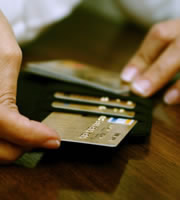Credit card debt: is the worst over?

Earlier this week, this blog highlighted the holiday bonuses that many credit card rewards programs are currently offering. These, it was suggested, were an attempt on the part of card issuers to persuade consumers to increase again the use of their products. It looks as if they may have their work cut out.
Credit card debt down–yet again
The Federal Reserve published its monthly analysis of consumer debt Tuesday, and it showed that Americans wiped $5.6 billion off their collective credit card balance in October. That’s no surprise. According to The Wall Street Journal, credit card debt hasn’t shown an increase since August 2008.
The average in that year was $957.5 billion, compared with this October’s $800.5 billion, so consumers have reduced what they owe on credit cards by $157 billion, or 16.4 percent.
Delinquencies set to decline?
On the same day the Fed published its statistical release, TransUnion, which maintains a national consumer credit database, unveiled its annual forecast for debt. And that too sounded good. It expects that in 2011 the rate of serious credit card delinquencies (accounts 90 days or more past due) will fall by more than 10 percent, from 0.75 percent at the end of this year to 0.67 percent at the conclusion of next.
Ezra Becker, who is vice president of research and consulting in TransUnion’s financial services business unit, commented:
Many factors have influenced the way consumers view and utilize credit card credit, including the Credit CARD Act, which has shifted the way lenders market and price this instrument; the payment hierarchy flip consumers displayed this past year — paying credit card bills before their mortgages; dramatic increases in the volume and duration of unemployment; and of course, home value depreciation.
Credit card use down too
Yesterday, the Fed released another report, this time about the number of non-cash payments for each type of instrument. It showed that debit cards were used on 37.9 billion occasions in 2009, up by 12.8 billion. In the same year, credit card payments fell by 100 million to 21.6 billion. Prepaid cards managed only six billion transactions, but was the fastest growing type of payment, showing annual increases of 21.5 percent from 2006-2009.
Credit card companies glum?
Of course, credit card companies are likely to be happy about the fall in delinquencies. But they may be distinctly unhappy about the fall in debt, and the reduction in the use of their product.
Card issuers have only two sources of income:
- Interest charged on balances, plus penalty fees
- Interchange fees, which are the cut of each transaction that merchants must pay to credit card companies for the privilege of swiping a card
If balances are lower, then the total interest charged should be too. And if credit card use is down, then interchange fees are also likely to be reduced. In other words, both the companies’ main revenue streams are looking seriously iffy.
Credit card rates–rises not the answer
So far, the banks’ main reaction seems to have been to hike credit card rates in an attempt to make up the revenue shortfall. But, for many consumers, that merely serves as a disincentive to carry forward balances, and may explain some of the reduction in debt.
So it looks as if card executives will have to come up with new ways to get consumers to use their credit cards again.
Low interest credit cards
If you have a great credit report, you could be eligible for one of the low interest credit cards that are still offering rates below 10 percent. For example, Nordstrom Platinum Visa has rates that start as low as 7.9 percent APR, while the Wells Fargo Platinum Visa Credit Card manages to beat even that at 7.65 percent APR.
Both these rates are likely to be available only to those with the most impressive credit reports. But, if you get them, they could help you to see credit cards in a whole new light. Or, rather, in the way you used to.
Disclaimer:The information in this article is believed to be accurate as of the date it was written. Please keep in mind that credit card offers change frequently. Therefore, we cannot guarantee the accuracy of the information in this article. Reasonable efforts are made to maintain accurate information. See the online credit card application for full terms and conditions on offers and rewards. Please verify all terms and conditions of any credit card prior to applying.
This content is not provided by any company mentioned in this article. Any opinions, analyses, reviews or recommendations expressed here are those of the author’s alone, and have not been reviewed, approved or otherwise endorsed by any such company. CardRatings.com does not review every company or every offer available on the market.
Published (Modified )